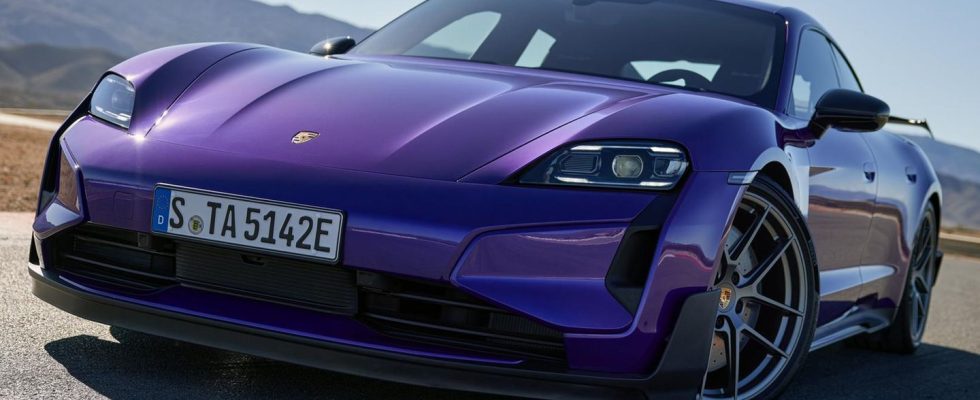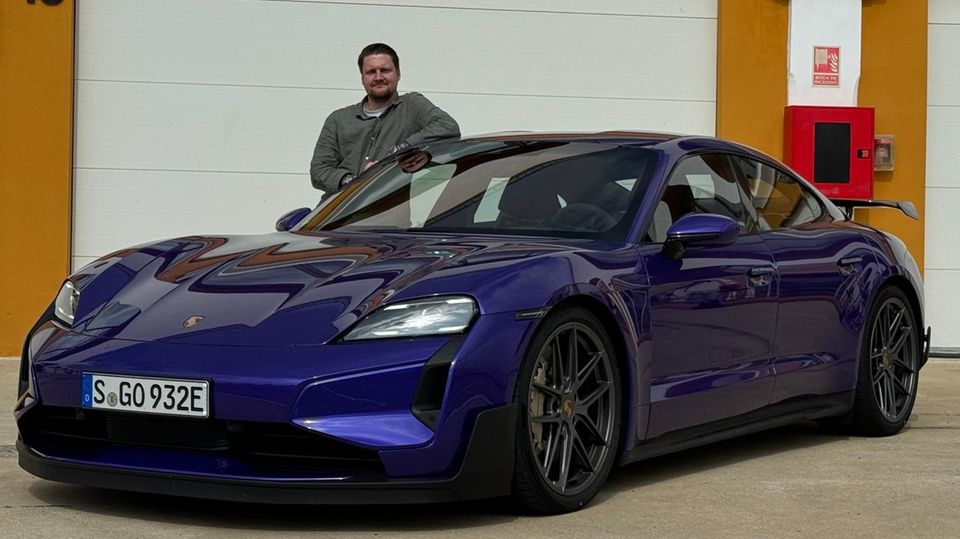In the world of electric cars, the 1000 hp limit falls quite often – it’s actually just a question of money and how much power the drive provides. But it takes more than raw power to make the vehicle fast. With the Taycan Turbo GT, Porsche wants to provide the reference on the racetrack. In conversation with the star Taycan spokesman Mayk Wienkötter reveals what it takes.
What has Porsche learned from the first Taycan and adapted accordingly in the new edition?
Mayk Wienkötter: A lot, I have to say. The learning curve was extremely steep because it was Porsche’s first fully electric car. The knowledge we gained was incorporated into the second generation. This particularly applies to the areas of performance, range and charging. We have made further improvements here. The acceleration and charging performance were already very good, but we have worked on further improving the 0-100 km/h values and charging behavior. With a lot of effort, we have achieved even better performance in the new vehicle.
Now that’s it Taycan, especially the GT, a thoroughbred sports car. This raises the question to me: what does such a super sports car need apart from the pure engine power, which you can now often find in the data sheets of electric cars? The 1000 hp limit is constantly falling these days, so there must be other differences.
Chassis, steering and brakes. Everything has to fit. The power must remain controllable. This means, for example, high recuperation of up to 400 kW for deceleration and an additional large-scale braking system. Of course, the chassis and steering also play an important role for Porsche. At the end of the day, no Porsche should be too different from our traditional sports cars, regardless of what engine it uses. The feeling must at least be similar. This is a big challenge.
In connection with the Taycan and the launch control, in which you are fired forward with 1340 Nm of torque, I have heard more than once that even seasoned experts were close to their physical limit. Is available for Electric cars a performance limit because people can no longer tolerate it at some point?
You can’t say that because it actually depends on the driver. If you ask our record driver Lars Kern if he would like another 1000 hp, he will say yes because he can handle it. The most important factor is the controllability of the power. If everyone can operate the car in a way that he or she feels comfortable with, we have done our job well. In some modes the cars show what is possible, in others you cruise comfortably over the road despite the sports car feeling – that’s the real art.
Speaking of record drivers. Porsche often talks about the two records on the Nordschleife and in Laguna Seca. What is the message behind it, apart from the fact that the Taycan is obviously a potent sports car?
We want to show what our electric car is capable of. Driving straight ahead very quickly in an electric vehicle is relatively easy. More power and you’re faster. But when it comes to mastering a race track and doing it quickly, then you need other, higher quality components. The car then has to go around the corner quickly. It is also part of our brand identity to trim the cars for maximum Nordschleife performance – that is what customers expect and we also want to bring that into the new era.
How closely do you monitor cars like the Tesla S Plaid or the Lucid Air Sapphire, which are actually in direct competition with the Taycan in terms of performance, even though, to put it bluntly, they are family sedans?
Every manufacturer with comparable performance is a competitor. We don’t ignore that. But at Porsche we traditionally concentrate more on ourselves and always measure ourselves against our own specifications first. Comparison with our own products is also important because we need to know where we stand and how we can achieve further improvements.
Let’s take a look at electric car technology. The Taycan can charge with up to 320 kilowatts – that’s an absolute top value. But I think it’s not that easy to find suitable columns. What is Porsche doing to ensure that super-fast charging at a suitable charging station does not remain an isolated case?
On the one hand, we have already opened three Porsche Charging Lounges. Of course there are the right loaders there. But above all, we are working together with our joint venture Ionity and other manufacturers to advance the expansion of the charging infrastructure. The Ionity network now has over 600 locations across Europe. And you can always charge with up to 350 kilowatts.
Never had any problems? I know it differently.
I just drove 2,300 kilometers from Stuttgart to Seville in the new Taycan. We are already very well positioned in Central Europe. But the further south you go, or east in the periphery, it becomes a bit more challenging. On my trip, for example, I had no problems at all until Barcelona. But from Valencia onwards the charging network becomes noticeably thinner. For example, I was suggested two charging locations, both of which were defective. Only the third suggestion from the Porsche Charging Planner worked. This is extremely unpleasant for a customer who has no experience with the topic. When I imagine that this is the first time I’ve traveled long distances in an electric car, that’s not a good signal. This definitely needs to get better.
Technology is making progress
Charging stations of the future: The waiting time with an electric car should finally be shorter
Tha’ts what I meant.
Yes, unfortunately there are always cases in which the charging infrastructure does not work. Clearly, reliability needs to be increased. If a charging station is approached, it must also work. There is still a lot of work ahead of us.
Reliability is a nice keyword. Does it actually damage the battery if you constantly charge the car with the said 320 kilowatts every time? When it comes to electronics, you often hear that it’s best to do it as slowly, i.e. gently, as possible and that fast charging always comes at the expense of the battery.
Absolutely. Ultimately, this is also a lithium-ion battery. But practice shows that this is less important in our cars and has less measurable impact than expected. We not only examined cars with extremely high mileage, but also carried out tests in which we charged the batteries over and over again under full load. If you read the so-called SOH, i.e. the state of health, or “state of health” of the battery, you will always see that battery aging only plays a minor role. That’s why we give an eight-year or 160,000-kilometer guarantee on the component. The customer should have to worry as little as possible about how and when they charge.
The term “to-go cup” is often used in connection with electric cars, which means that the cars are intended for one-time use, since replacing a battery would always be a total economic loss. How much does a new battery cost at Porsche if it breaks outside of the warranty period?
This is not a realistic scenario as it would mean all 33 modules failing at the same time. But they can all be exchanged individually. If something is wrong, we find out what the problem is and only replace the defective module – this saves costs.
Sports car
Porsche Taycan Turbo GT: The “most powerful production Porsche of all time” in pictures
How much does a Taycan battery module cost to exchange?
Changing a module in the Taycan high-voltage battery costs around 6,000 euros. The material costs are around 1,700 euros. Since the entire HV battery always has to be removed and reinstalled, if several modules were replaced, the price per module would be reduced accordingly.
With the Taycan, Porsche has now reached 18 minutes for charging from 10 to 80 percent – that’s very fast. But is the final goal?
One day the charging process should not take longer than the refueling process.
When is the time?
The path has been taken, that much is certain. But it will still take some time. This is not something we will see in two or three years. But I am convinced that it will happen at some point.
Let’s assume that this happens in eight or ten years. Then the warranty for the battery would have just expired on a Taycan that I buy today. So the car isn’t old yet. Could I then go to Porsche and say: “Bring on the new super battery”?
This is technically possible. But it is relatively complex and expensive. If costs are not an issue and such technical changes are permitted, this could be done. We have to look at whether this is also economical.
I’m asking because I can’t imagine a classic car meeting in 30 years where there’s a 2024 Taycan in the yard. She?
I’ll just get my crystal ball out. Moment. (Break)
GT4 RS
Over 180,000 euros new price, but three days under water: This destroyed mud Porsche is supposed to drive again
And?
Of course I don’t know either. But I hope that we will also see a Taycan and that there will be the technology to keep these cars cost-effective, of course. Because a Taycan GT with the Weissach package will still be a special sight in 30 years. I do believe there will be a corresponding scene. Of course, I don’t know whether the enthusiast scene as a whole will still be as vital as, for example, with the air-cooled 911s. After all, there are over 60 years of tradition behind it. You have to build it up first. These shoes are already very big. But I am convinced that in the next generation there will be people who say “that was the first two-seat, four-door electric sports car! I would like to have that”.
That’s right, the Weissach GT has four doors, but only seats at the front. Why not two doors?
This is a cost aspect. If you left out the doors, you would have to adapt the entire body. You can build a new car straight away. This is incredibly complex and just as expensive. That’s why it was never discussed. You have to look at it differently: The version with the Weissach package does not cost any extra for the Taycan – completely different to the GT models of the 911.
Transparency note: This trip to Spain to test drive the Taycan was at the invitation of Porsche.



